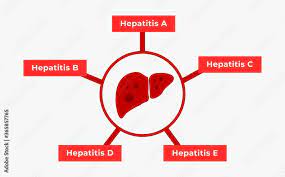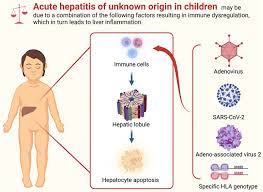Causes of Hepatitis

Viral Infections: The most common causes are hepatitis viruses, specifically types A, B, C, D, and E. These viruses differ in their modes of transmission and severity.
Alcohol and Drugs: Excessive alcohol consumption and certain medications or toxins can induce hepatitis, termed alcoholic hepatitis or drug-induced hepatitis.
Autoimmune Disorders: The body's immune system mistakenly attacks liver cells, leading to autoimmune hepatitis.
Metabolic Disorders: Conditions like fatty liver disease can trigger inflammation, progressing to hepatitis.
Types of Hepatitis

Hepatitis A: Typically transmitted through contaminated food or water, causing acute infection. Vaccination is available for prevention.
Hepatitis B: Transmitted through blood, bodily fluids, or from an infected mother to her baby during childbirth. It can lead to chronic infection and complications without proper treatment.
Hepatitis C: Mainly transmitted through blood-to-blood contact. It often progresses to a chronic stage and can cause severe liver damage if left untreated.
Hepatitis D: This virus infects only in conjunction with hepatitis B, worsening its effects.
Hepatitis E: Similar to hepatitis A, transmitted through contaminated water. It's common in areas with poor sanitation.

Evasion and Prevention
Vaccination: Vaccines are available for hepatitis A and B. Vaccinating against these viruses is a primary preventive measure.
Hygiene and Sanitation: Maintaining good hygiene, especially in food preparation and water consumption, helps prevent the spread of hepatitis A and E.
Safe Practices: Using protection during sex, avoiding sharing needles or personal items that may carry blood, and practicing safe tattooing or piercing procedures help prevent hepatitis B and C.
Moderation in Alcohol Consumption: Reducing alcohol intake minimizes the risk of alcoholic hepatitis.
Regular Screening and Treatment: Timely screenings for hepatitis B and C can lead to early detection and effective treatment, preventing chronic liver damage.
Educational Campaigns: Raising awareness about the modes of transmission and preventive measures through community education plays a pivotal role in curbing hepatitis.
Understanding the causes, types, and preventive measures associated with hepatitis is crucial in minimizing its impact and ensuring better liver health for individuals and communities worldwide. Early detection, vaccination, and adopting healthy lifestyle practices are key elements in the fight against hepatitis.
Hepatitis
a term got from the Greek words "hepar" and "itis" meaning liver and bothering, independently, is an overall prosperity concern impacting an enormous number of people. This liver disturbance can result from various causes, presenting an extent of troubles for the two individuals and clinical benefits structures all over the planet. In this article, we will dive into the different pieces of hepatitis, including its causes, types, and preventive measures. Explanations behind Hepatitis: Hepatitis can be achieved by viral defilements, alcohol abuse, toxic substances, and insusceptible framework disorders. Viral hepatitis is the most generally perceived, with five principal sorts - A, B, C, D, and E. Hepatitis An and E are routinely achieved by finishing soiled food or water, while Hepatitis B, C, and D are mainly spread through contact with spoiled blood or regular fluids. Alcohol abuse can provoke alcoholic hepatitis, a condition where superfluous alcohol use hurts the liver over an extended time. Harms like explicit medications, engineered substances, and plants can in like manner add to hepatitis. Additionally, immune system hepatitis occurs when the immune system targets the liver cells incorrectly. Kinds of Hepatitis 1. * Hepatitis A (HAV):* This type is by and large sent through corrupted food or water. While it can cause trouble, Hepatitis A by and large settle in isolation without causing continuous liver sickness. 2. * Hepatitis B (HBV):* Hepatitis B is a potentially fatal infection that can spread through contact with contaminated blood, unprotected sex, or from a pregnant woman who has been infected to her child. Diligent Hepatitis B can incite challenges like liver cirrhosis and liver sickness. 3. * Hepatitis C (HCV):* Hepatitis C is mostly spread through contact with blood that has been contaminated. It frequently progresses into a chronic condition, eventually leading to liver damage. The development of potent antiviral medications has largely improved the outlook for people with Hepatitis C. Hepatitis D (HDV):** This type simply occurs in individuals who are at this point spoiled with Hepatitis B. HDV can make the symptoms of Hepatitis B more limit and is connected with a higher bet of liver damage. 5. * Ebola virus (HEV):* Like Hepatitis A, Hepatitis E is normally sent through corrupted water or food. It is typical in locales with lamentable cleansing and can be particularly unsafe for pregnant women. Preventive Measures: Thwarting hepatitis incorporates a mix of inoculation, embracing safe practices, and lifestyle choices. Immunization is an important preventative measure, especially for Hepatitis A and B. The antibodies have proven to be very effective at reducing the risk of infection and preventing serious problems. Practicing safe neatness is major in thwarting the spread of hepatitis. This consolidates washing hands totally, especially ensuing to using the bathroom and preceding dealing with food. Safe food and water practices, for instance, avoiding half-cooked fish and drinking just fittingly treated water, can on a very basic level reduction the bet of hepatitis An and E. Using security measures to thwart the transmission of Hepatitis B and C is imperative. This includes practicing safe sex, trying not to share needles or personal hygiene items that could come into contact with blood, and making sure that sterile equipment is used in medical settings. Early detection through routine screenings is crucial for people who are frequently infected with Hepatitis B or C. Advantageous clinical intervention can help with managing the development of the ailment and reduce the bet of burdens. Likewise, lifestyle choices, such as limiting alcohol usage and avoiding pointless receptiveness to harms, can add to liver prosperity. Challenges and Overall Impact: Notwithstanding colossal progression in getting it and supervising hepatitis, challenges persevere. Nonattendance of care, confined induction to clinical consideration, and social characteristics of disgrace related with the sickness obstruct expectation and treatment attempts. In numerous region of the planet, particularly low-pay areas, permission to vaccinations and clinical interventions stays limited. The overall impact of hepatitis is huge. Constant hepatitis defilements are critical allies of liver cirrhosis and liver illness, putting a tremendous load on clinical benefits systems. The financial impact is moreover critical, with costs related with clinical thought, lost productivity, and the social consequences of relentless infection. Conclusion: Overall, hepatitis is a perplexing and complex medical issue that affects a large number of people worldwide. Getting a handle on the causes, types, and preventive measures is dire for the two individuals and organizations. Vaccination, safe practices, and early distinguishing proof are key parts in the fight against hepatitis. Overall undertakings to increase care, further foster induction to clinical consideration, and decrease the social shame including the contamination are essential to truly address the troubles introduced by hepatitis and advance liver prosperity on an overall scale.



You must be logged in to post a comment.